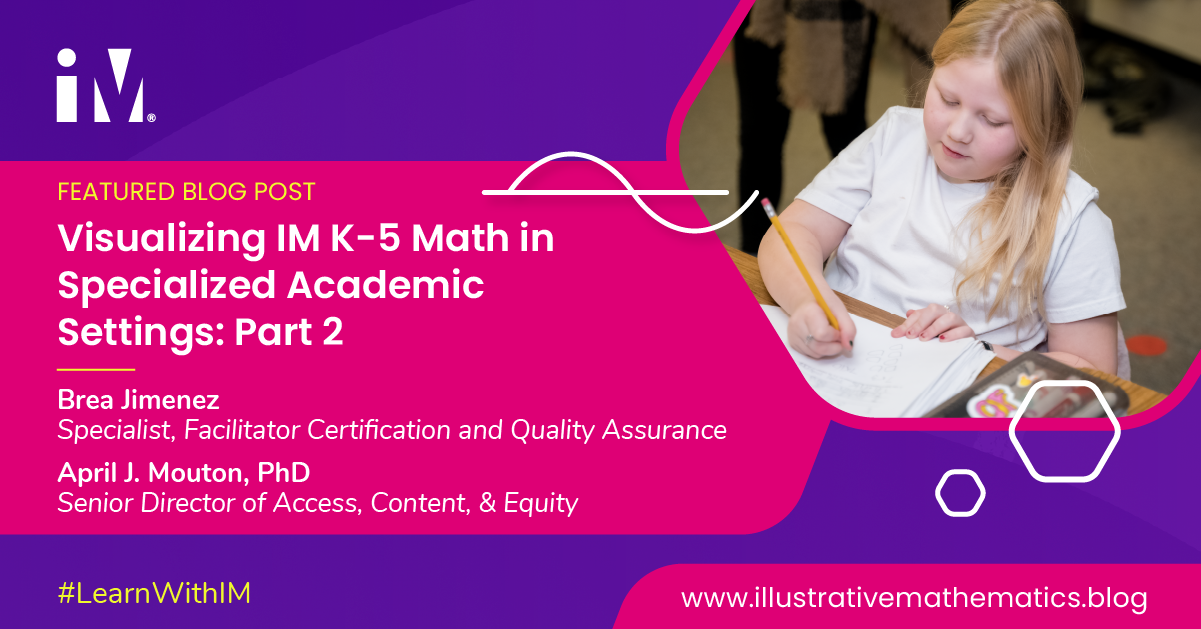By Brea Jimenez, Specialist, Facilitator Certification and Quality Assurance and
April Mouton, Senior Director, Access, Content & Equity
IM believes in a world where all learners know, use, and enjoy mathematics. We also believe all students deserve access to playful discovery, critical thinking, and self-determination in mathematics. For some of our students, these goals require more intensive supports. However, this does not mean they should be limited to memorization and retrieval mathematical experiences. Using IM as a part of a team of supports can help ensure that students with exceptionalities are empowered and inspired to explore the story of the math.
IM K-5 Math is a Tier 1 instructional curriculum. In collaboration with specialized academic instruction, accommodations, modifications, and supports, IM enriches learning environments and reduces barriers of access through the UDL-framework and invitational approaches. IM leverages the teacher in the role of facilitator and for some populations of students, this may require some adjustment. The role of the teacher as a facilitator can exist at different prompting hierarchies and with more than one teacher present. In this blog, we will look at a specific IM lesson and explore how it can be successfully integrated in an environment with specialized academic instruction and Tier 1 core curriculum (See Part 1 Blog for Push-In/Paraprofessional Supports).
This section will cover two key considerations in successfully integrating IM K-5 Math into a targeted support setting using a fourth-grade lesson example:
- Leveraging the Overarching Design Structure
- Opportunities for Individualization
I. The Overarching Design Structure
Each unit, lesson, and activity follows a similar overarching design structure: an invitation to the mathematics (warm-ups and launches), a deep study of concepts and procedures (activities), and an opportunity to consolidate understanding of mathematical ideas (synthesis). The invitation to the mathematics is particularly important in offering students access to the mathematics, as it builds on prior knowledge and encourages the use of their own language to make sense of ideas before formal language is introduced. Both strategies are consistent with the principles of Universal Design for Learning. For students with exceptionalities, familiarity and repetition can help promote global generalization of concepts and procedures. Since IM’s overarching structure is woven into the unit, lesson, and activity levels, students become familiar with the layout and benefit from the predictability of the structures and routines.
Invitation to the Mathematics
The invitation to the mathematics is an open, accessible opportunity for all students to engage in mathematics and feel confident in their abilities to provide meaningful input. In our 4.1.3 example, this is our warm-up:
Choral Count

For students with mild to moderate disabilities, a choral count is a wonderful invitational activity. Some ways to empower students to scaffold this experience for themselves could include: modeling the choral count with the entire class before asking them to count without the teacher’s assistance, providing written cues, or playing a song or video to assist with the choral count as students count along. Students may also benefit from being explicitly invited to count in their first language, ASL, or with an assistive communication device. Regardless of the differentiating moves a teacher may make, it is important to capture the count visually for students to see as they move through the lesson.

For this section, it may be beneficial to allow students to discuss in small groups or use the Stronger and Clearer Each Time math language routine to allow for collaboration and revision. Consider reframing the questions for students who may require a more explicit path. For example, “What patterns do you see in the individual counts?” could be reframed as “What do you notice about the 2s and the 4s here?” It may also be helpful to have these pre-selected questions listed on a board or anchor charts for students to ask each other.
Deep Study of Concepts and Procedures
The deep study of mathematics includes instructional activities in which students are introduced to and make connections between new concepts, procedures, contexts, or representations. In our 4.1.3 example, we will look at Activity 1:

Allow students the space and time to process and respond before increasing the hierarchy of prompting. Since students are receiving physical cards for this sorting activity, there is room for a variety of differentiation strategies. Teachers can provide students with fewer cards to decrease task fatigue but still challenge their learners. The facilitator in the classroom may choose to ask some probing questions (ie. “Why does this one go here?” or “What card goes with this one?”) if students are showcasing uncertainty or trouble beginning the task.

For the area portion of this activity, consider visual aids and guides for calculating area. For example, post an anchor chart with the procedure for calculating area in a few different ways. It may be helpful to have a designated “I’m stuck” anchor chart with clues and reminders to help get students back on track. Students may have accommodations that require explicit directions. For those students, consider providing procedural steps on a piece of paper at their desk without including insight on “how” they will solve the problem. (For example, 1.) Find the length of one side. 2.) Find the length of the other side, etc.)
Facilitating discussion about creating new rectangles does lean into some abstract thinking. To ground this conceptually, consider having some direction on the number of groups they will have and how they will know when they have finished. For example, this could be scaffolded by having the students list the factor pairs as they encounter them and crossing them off when they have been used in a rectangle. Once all the factor pairs have been used, they will know they are done with that number. Another strategy can include targeted questions such as, “Can you arrange these tiles to make a rectangle that is not the same as the ones on these cards?” or “What happens when you try to make another rectangle with an area of 7?” As students think through the activity, you can provide cubes or small, square pieces of paper to help add a tactile element for students.
Consolidating and Applying
Consolidation and application of mathematics facilitates meaning-making. This activity ends with a synthesis to ensure students have an opportunity to consolidate their learning by making connections between their work and the mathematical goals. In our 4.1.3 example, this is the Activity Synthesis:

For this activity synthesis, consider circling the number of factor pairs in each area category while counting aloud. (i.e. “1-2-3. 18 has 3 factor pairs. 1. 7 has 1 factor pair.”) Have students verify this information, “Does 36 have more than one factor pair? How do we know?” Capture student responses visibly and affirm any responses by repeating to all students in the classroom. Anchor in the new vocabulary as listed, but consider repeating more than once and having the students repeat the terms back to you (using whatever method of communication they are able to).
When considering adjustments for differentiation and scaffolding, it is helpful to consider the intended outcome of the question or conversation and the least number of supports it will take for a student to meaningfully participate, as opposed to the least number of supports it will take them to get the correct answer. A special education program does not ensure that a child never provides an incorrect answer, but rather if they do, ensures that it is not a result of their disability. The teacher-facing learning goals of this lesson state:
- Determine whether a given whole number in the range 1–100 is prime or composite.
- Find the factor pairs of a given whole number 1–100.
In the context of the learning goals, a student will need enough supports to engage with the math. This includes finding a procedure for interacting with these problems that makes sense to them. For example, students do not need to find all the factor pairs of all the rectangles to experience that 7 is different from 18, 24, and 36, and successfully participate in the synthesis. Supports could include a task analysis breakdown with actionable steps, a multiplication chart, manipulatives for counting, or pre-scheduled brain breaks. Supports are sufficient if students can engage with the mathematics, follow through their selected solution path, and provide their answer. IM’s Responding to Student Thinking and Next Day Support suggestions can provide further guidance on supporting students who arrive at incorrect answers.
Students with exceptionalities will likely need more time and exposure to concepts and procedures to internalize and globalize them. As often as possible, revisit key concepts and skills outside of “math time.” Centers provide an excellent resource for continuous assessment and practice.

Explicit instruction may present as an accommodation on a student’s Individualized Education Plan (IEP). The Activity Synthesis and Lesson Synthesis are great opportunities to anchor that support in tandem with the problem-based learning the student is experiencing. If students are showcasing difficulties with the presented questions, it may be helpful to reframe the questions in the synthesis as closed, true statements or sentence frames with an opportunity for the students to showcase understanding (ie. If we can only find one rectangle, the number is prime, who remembers a prime number we worked with today? Tell me using this sentence frame “The number ___ is prime because it has only one factor pair”) Then, anchor that understanding through the steps taken to find the information (ie. How do you know ___ has only one factor pair?) This is an excellent opportunity to create trials and take data to inform instruction for the next lessons. If visuals or sentence frames were used on how to find factors and multiples, consider leaving them visible and accessible throughout the remainder of the unit.
II. Opportunities for Individualization
IM’s belief is that all students should know, use, and enjoy mathematics. There is no “one size fits all” approach to any aspect of learning. For some of our learners, knowing, using, and enjoying mathematics will involve specialized academic instruction, instructional accommodations, and supports. For this section, we will focus on three areas that can be individualized for students with mild to moderate disabilities: instructional routines, launches, and centers.
- Instructional Routines: Instructional routines create structures so that all students can engage and contribute to mathematical conversations. Instructional routines have a predictable structure and flow. They are enacted in classrooms to structure the relationship between the teacher and the students around content in ways that consistently maintain high expectations of student learning while adapting to the contingencies of particular instructional interactions (Kazemi, Franke, & Lampert, 2009). IM K-5 Math uses ten warm-up routines and eight math language routines. These routines have the same format and structure each time they are encountered, with variations mainly in the actual images, materials, and context included.
- When the instructional routines are encountered, a teacher may choose to have a set protocol for the activity for specific students. For example, for students with high anxiety sharing out, their notice and wonder routine could include writing their thoughts down to be collected. For students who have verbal processing delays, a notice and wonder routine could include a sentence frame they access as needed. For students who need frequent movement breaks, a notice and wonder routine can include collecting the notes from students who did not wish to speak aloud. As these instructional and math language routines become part of the classroom and school culture of learning and doing, the individualization a teacher imparts can run automatically whenever that routine is encountered.
- Launches: During the launch, the teacher makes sure that students understand the context (if there is one) and what the problem is asking them to do. This is not the same as making sure the students know how to do the problem—part of the work that students should be doing for themselves is figuring out how to solve the problem. The launch invites students into the lesson and helps them connect to contexts that may be unfamiliar. For students with exceptionalities, the endless possibilities at the end of a launch may be difficult for them to synthesize into actionable steps. For example, students with working memory and task analysis barriers benefit from having launches broken down into steps. It may be helpful to explicitly state what they are expected to do out loud with audio or visual cues such as timers to help them keep track of elapsed time. It is still on the student to do the math and find the technique that works for them (preserving the ‘aha’ moment), but this eliminates the “Where do I begin?” barriers that could negatively impact their confidence in the exploration.
- Centers: Centers are intended to give students time to practice skills and concepts that are developed across the year. There are two types of centers in IM K-5: addressing centers and supporting centers. Addressing centers focus on the work of a lesson or section of a unit, whereas supporting centers review prior unit or grade-level understandings and fluencies. Since centers present in a familiar and predictable format, it is an excellent vessel for individualized instruction. For example, in Five in a Row, the center featured in our example Unit 1, the instructions are as follows:

One way this can be individualized for a student who may become fatigued or overwhelmed quickly is by reducing the size of the game boards. This can be accomplished by either making it three or four in a row to win or by focusing on a couple factors at a time (i.e. 1-3 or just 5 and 10). This preserves the rigor, cognitive demand, and intent of the center and additional rows and factors can be added back in as the student progresses. Strategic partnerships, such as partnering students with classmates who can model key strategies or language, can also support individualizing this center for a student. Another way to individualize centers is to play the center with them and support their progress with immediate feedback, error correction, and positive reinforcement. Centers can also be sent home to families for additional practice.
For specific concepts, some students may need additional accommodations or curricular modifications to increase access to the learning environment. On the dream team of supports, IM plays the role of the foundation. IM’s UDL integration and overarching structure makes high-quality, grade-level instruction more accessible for students with exceptionalities. In partnership with the specialized academic instructor as our MVP, even more learners can know, use, and enjoy grade-level mathematics.
Excited to see IM modeled in an Environment 3 setting? In future blog posts, we will revisit this lesson for Environment 3 (self-contained specialized academic instruction)!
Reflection Questions:
- When preparing lessons for students with exceptionalities, how can you best prepare an environment that supports their participation?
- How can we ensure all learners have access to productive and joyful mathematical exploration?
- How can we leverage our role as the facilitator to provide meaningful access ramps to grade-level mathematics for students with exceptionalities?
 April Mouton
April Mouton
Senior Director, Access, Content & Equity
April J. Mouton (she/her/sis) received a BA in political science and minors in mathematics and African studies from the University of California, Davis. She received her MEd in counseling education, K-8, administrative, and pupil personnel credentials from San José State University. She has served as a mathematics and cultural studies teacher, administrator, and consultant for 22 years. April is currently the senior director of access, content, and equity at IM and a doctoral candidate at Texas State, with a focus on demystifying mental health, culturally responsive teaching, identity formation curriculum integration, leveraging ancestral knowledge, and equity forward systems. She is the mother of three dynamic children, and her husband is a writer and educator.
 Brea Jimenez
Brea Jimenez
Specialist, Facilitator Certification and Quality Assurance
Brea J. Jimenez (she/her/hers) received a BA in English from Ottawa University in Ottawa, Kansas. She received an MA in Special Education from the California State University of Bakersfield. She is dual-certified in K–12 moderate to severe special education (exceptional children) and early childhood special education. She holds authorizations for English learners and autism populations. She has spent her classroom and administrative career working with Pre-K to 22-year-old students with exceptionalities in a wide variety of inclusion, self-contained, and transition settings. Brea is currently the facilitator certification and quality assurance specialist at IM. She has a passion for universally accessible classroom design and empowering all learners to have agency over their educational experiences. She is a zealous knitter, the mother of two children and two cats, and proud partner to a US Navy Veteran.
